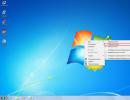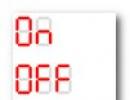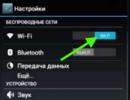What is a context menu? A detailed analysis of the Windows context menu options.
Absolutely all computer users encounter the concept of a context menu, regardless of the type of operating system used or its developer. Such an element is available in all currently known operating systems. But let's take a look at what the Windows context menu is, what types there are, and how to use it. We take Windows as a basis only for the simple reason that most users in the post-Soviet space work with these operating systems. And first, a few words about the term itself.
What is a context menu in general understanding?
Actually, the name of the menu itself comes from the English context. As for a simplified understanding, the context menu of Windows 10 or any other operating system can be interpreted as some additional element of the system’s graphical interface, which contains certain quick access commands to some basic or additional functions.
So to speak, in the context of selecting an object for which an additional menu is used, different commands will be available (this will be discussed separately).
Menu types
Actually, the operating system itself has several types of main and additional menus. For example, the main menu is accessible by clicking the Start button. Installed programs usually have their own element in the form of a top panel, which displays sections of basic operations, etc. Naturally, all such menus differ from each other both in appearance and purpose. But it is the context menu that is universal in its own way and, in a sense, even connects applications with the operating system without the use of additional tools. Forgot how to perform some action? It's OK! This menu will tell you what and how you can do, especially since many menus of this type can open additional lists.
Context menu items
As already mentioned, the contents of the menu can differ quite significantly for different objects. It all depends on the type of object selected and the actions that are supposed to be performed. Everyone knows that in Explorer, through such a menu, when you select a file or folder, you can specify copying, moving, deleting, opening, and performing a lot of other operations, not counting the use of hot keys or their combinations.

On the “Desktop”, when you click on an empty area of the screen, you can quickly call up screen settings or create shortcuts. But to carry out such actions, following the standard methodology, will take much more time. In general, it is believed that the context menu is a unique invention. Despite the fact that almost all the points it contains are duplicated by the operating system itself and some installed programs, its use often reduces the time it takes to access certain actions and functions.
Differences between menus for different objects
Now let's look at the most important question regarding how menus of this type differ when selecting a specific object. It goes without saying that it will not be possible to describe all types, so we will focus on the most basic ones.
We've sorted things out a bit with files and folders. It can be added that antiviruses, archivers and some other programs build their own commands into such menus, so in addition to a set of standard actions, you can use their additional capabilities.

If you are using the menu for a disk or partition, you can already access system tools here. Programs have their own elements of this type, but the context menu for almost all active applications, if the upper left corner of the program window on the header is used as the selected object, the items are the same: closing, moving, minimizing and maximizing the active window, resizing, etc. It is clear that the content of each context menu for applications depends on the specific use of the program. Thus, in web browsers, among the items there are commands related specifically to actions with tabs or settings.

When you use the menu for panels, you can customize them, go to additional options, add or remove elements, etc. As already mentioned, it is simply physically impossible to describe the contents of all types of menus that open, so let’s move on.
How to open an additional menu: several basic methods
Now a few words about how to call or open the context menu. Everyone knows that in Windows, RMB is used for this (click on This action is set in the default settings, although some use button reassignment, after which this control is called with the left button. In general, the mouse context menu, depending on the type used manipulator, you can configure it as you like. For example, for the same gaming mice, which have a lot of additional buttons, accompanying software is usually installed, which allows you to control all their parameters and configure the buttons for a specific action, including calling additional ones. menu.
Few people know that in Windows you can use not only RMB. For example, for laptops it is very important to use the combination Shift + F10. The right button on the touchpad is also used for this. On some non-standard keyboards for stationary computer terminals you can find a special Menu key, which is usually located to the right of the Win button.
How to add additional items to the menu?
Finally, let's look at how to add additional items or commands to the context menu. You can, of course, use Windows tools, but to do this you will have to delve into the registry, and this is very inconvenient.

The easiest way is to use the small Context Menu Tuner program, the interface of which consists of only two panels with sets of commands and areas of Windows Explorer.

There are only two buttons for adding or removing elements, so there should be no difficulties in using them.
Practical advantages of use
As for the advantages, a lot has already been said about them. This concerns not only the fact that the correct call of some actions can simply be forgotten. The versatility of such menus lies precisely in speeding up access to some standard and non-standard functions or actions, which would take much longer to call in the usual way. And so - RMB and all the necessary commands are at hand!
Instead of a total
I would like to hope that after reading the above material, many have figured out what this element of the operating system is. As for its use, there should be no questions at all, since in some situations you simply cannot do without it. And practice shows that one hundred percent of one hundred users always use the context menu, regardless of the actions performed.
The Explorer context menu is the menu that appears when you right-click (Right Mouse Button) on some object (file or folder) or simply on an empty space in a folder or Desktop. If your system is new, then the context menu will be relatively empty. Is it just something added from the video card drivers, for example like this:
but if the system has been installed for a long time, then there will be more such points. For example like this:

As you can see, over time, in addition to the standard menu items, more installed programs were added. On the one hand it is convenient. After all, you don’t need to launch a shortcut or search for a program, but you can directly perform actions right from the context menu. But on the other hand, over time there are a lot of such items and sometimes you even have to scroll up or down the context menu in search of the necessary items.
Therefore, sometimes you want to remove these items so as not to get in the way. After all, you don’t use all the points often.
So how remove item from context menu.
In order to remove a program item from the context menu (CM for short), you can use both standard methods of the Operating System itself, and using the programs themselves or specially designed ones.
The easiest way to remove it is to look in the settings of the program (which you want to remove) for the desired item. Usually it is located somewhere in Integrations or Loading/adding. For example, in order to remove the famous WinRAR item from KM, you need to uncheck the Shell integrations:

Other programs may also have similar settings.
It’s another matter when you haven’t found the necessary settings to delete or they don’t exist at all (this happens too). Then you can use the standard method of the systems itself, namely editing.
I warn you right away that before starting work it would be better to play it safe and make a backup copy of the registry.
So, let's launch the registry and go to the branch
HKEY_CLASSES_ROOT/*/shellexe/ContextMenuHandlers

and we see here these same items from the context menu.
Now right-click on the desired item (the item from the KM that you want to delete) and select Delete:

We agree with the following warning:

reboot and check. The item should disappear.
If you haven't missed it, check out the thread.
HKEY_CLASSES_ROOT\AllFileSystemObjects\ShellEx\ContextMenuHandlers
and do the same.
On a note:
If you want to delete an item specifically from KM -> Create

then you need to know the type of file () that is being created. For example, for Microsoft Office Access the file extension is .accdb, which means you need to look for it in the registry branch HKEY_CLASSES_ROOT, and then delete the ShellNew subkey there

If you want to remove from KM those items that appear when you RMB on folders, then you need to look at the branches:
HKEY_CLASSES_ROOT\Directory\shell
HKEY_CLASSES_ROOT\Directory\shellex\ContextMenuHandlers
HKEY_CLASSES_ROOT\Folder\shell
HKEY_CLASSES_ROOT\Folder\shellex\ContextMenuHandlers

For the item "Open with..." the thread answers
HKEY_CLASSES_ROOT\*\OpenWithList
For KM Logical drives branches:
HKEY_CLASSES_ROOT\Drive\shell
HKEY_CLASSES_ROOT\Drive\shellex\ContextMenuHandlers

You can also delete items using special programs. For example using ShellExView

Its principle is simple: select the desired item and click on the red circle at the top of the program. The main thing here is that Type was Context menu

Now a little about how create your own item in the context menu.
The fact is that adding such an item for folders or specific files, as well as in an “empty” space using the registry will not work. You can only assign it to when it opens with RMB on the Desktop. Therefore, I recommend reading the article and taking advantage of what is described there.
Well, or use another utility - Ultimate Windows Context Menu Customizer() which has a bunch of features, but in English. And there we only need to select the item and delete it:

If anyone is interested in more details and can’t figure it out, write in the comments and I’ll help. There, in the left column you need to select an item (computer, folder, files, etc.) where the context menu is called up, and to the right, select what to delete and click the Remove Item button at the bottom. If you are fluent in English, you will understand.
You can guess how to add your program to KM -> Create if you read the entire article carefully, namely about deleting one of this items. You just need to create a subsection on the contrary and write for the desired extension.
In general, the article turned out to be a little chaotic and more about removing it from the context menu, because... I think this is more relevant, and there is an article about adding. Therefore, if anything is not clear, write in the comments. Let's figure it out.
The context menu (right-click menu) is a convenient tool for speeding up work in Windows. Today we will reveal a few simple secrets of working with the context menu and the system registry. Read how to customize this important element to suit your needs without third-party applications, using only the built-in registry editor regedit.
How convenient is the context menu (right-click menu) and why clear it
I would like to immediately define the terminology so that there is no confusion in the future.
The Explorer context menu, or action menu as it is sometimes called, is a set of clickable commands right(contextual) mouse buttons on any file or folder. Depending on the object on which it is called, the menu will have a different appearance or "context".
Note. Of course, not only Windows Explorer, but also most installed applications have an action menu, because this is the most convenient way to access the most important commands.
Immediately after installing the operating system, the context menu has a standard and neat appearance, but as additional software is installed, new items are constantly added to it. Eventually, there are so many of them that using this useful tool becomes a chore. Therefore, it is critically important to be able to maintain the contents of the Windows context menu in order for fast and comfortable work.

This can be done in two ways:
- In semi-automatic mode, using third-party software.
- Manually, using the Windows Registry Editor.
Perhaps the first method may be a little easier, but with the second method there is no need to use various dubious programs downloaded from the Internet, everything is done using standard means.
Moreover, using the registry will allow you to delve deeper into the internal processes of the system and learn a lot of new things, so we will talk about the second option.
How to edit the Explorer context menu through the registry
Launch the registry editor:
- Enter the menu Start.
- Enter the command in the search bar regedit and press Enter.

Important! Any careless and thoughtless operations can have dangerous consequences, including complete failure of Windows to boot. To protect yourself from errors, be sure to make a backup copy of the registry before you start editing it!
Procedure for creating a backup registry file:
- Go to the menu " File" in an open editor.
- Select the item “ Export».
- In the window that opens, in the lower field " Export range", select " Entire registry».
- Specify the desired location and name of the new file and click “ Save».

Note.If problems arise after manual editing, the registry can be restored to its original state from a backup using the “ Import" on the menu " File» editor regedit.
As you can see, the registry itself has an original tree structure. The tree itself is displayed on the left side of the editor, and the list of parameters in the selected branch is displayed on the right. To work with the context menu, we are interested in only one section: “ HKEY_CLASSES_ROOT».

As already mentioned, different sets of commands correspond to different objects (folders, files), so you will have to edit them in the registry separately. Our main goals: clearing folder context menu And common menu items for all file types.
Important! We will not change the standard system context menu items through the registry. Only items added by installed applications are edited.
Clearing the folder context menu
All directory context menu settings are stored in branches:
... Directoty Shell.
... Directory Shellex ContextMenuHandlers .
... Folder Shell ex ContextMenuHandlers .

If you look closely, you can easily see familiar commands among the branches of these branches. So, a branch of the registry " Directory Shell" contains the items at the top of the menu, and " Directory Shellex ContextMenuHandlers» – bottom. " Folder ShellEx ContextMenuHandlers", basically repeats the content of the previous thread, so remove the same items from both threads if necessary.
All that remains is to remove the unnecessary commands. The choice of what to remove and what to leave on the list is a personal matter for everyone. Moreover, depending on the list of installed applications, the contents of the menu will differ significantly. Right-click on the unwanted registry entry and select " Delete" Then repeat this operation for the remaining selected elements.

This is the neat appearance of the registry branches in question and the menu itself after the cleaning procedure is completed.

Clearing the file context menu
The procedure itself is no different from that carried out in the previous section. Only the branches of the registry branch " HKEY_CLASSES_ROOT", storing the necessary parameters.
Now this:
...*shellexContextMenuHandlers.

They store common elements for all file types registered in the system.
Following the example of cleaning for folders, we delete all unnecessary branches in the registry and get a beautiful and convenient context menu.

Right-click menus are called contextual menus because their contents depend on context—in other words, on what program you're in and what you clicked on. File utilities, many free programs and other applications, to make them more convenient to use, often add their own commands and entire sections to the context menus. This is done, in particular, by the archivers WinZip and WinRar, as well as the email clients Outlook Express and The Bat!, which add commands for packing and sending by email as attachments to the context menus of files.
Unfortunately, the more such programs are installed, the longer the context menus, the more cluttered they are, and the more difficult it is to find the right command. The situation is further aggravated by the fact that many programs, especially free ones, have the problem that the context menu commands they created remain even after the programs themselves are uninstalled.
However, some utilities provide convenient ways to configure and delete context menu commands. This is the best and most reliable way to restore order. But if such a function is not in the program (or if you managed to remove it), the composition of the menu can be changed using the Windows system registry.
However, before you go into the registry (which is not always safe), let's look at several of the most common programs, which provide not only the creation of context menu commands, but also the ability to safely delete them.
WinZip Archives
The popular archiver utility WinZip adds several commands to file context menus (such as Add to Zip) or highlights them in the WinZip submenu. To configure these commands, start WinZip in "classic" mode (not Wizard mode) and select Options > Configuration. In version 8.1 and later, go to the System tab under Explorer Enhancements. In order not to rummage around too long to find the right command, in these versions you can disable the Display context menu items in a submenu mode - and then the archiving commands will be placed in the main menu, as in previous versions of WinZip.
To change individual commands, select or disable the appropriate items in the Context menu commands section. By disabling the Display icons on context menus mode, you can leave the commands in the menu, but remove the icons.
Finally, to completely eliminate WinZip commands from the context menu, disable Use shell extension (in versions 7 and 8) or Enable Explorer enhancements. However, keep in mind that you will lose the ability to extract content from the archive by right-clicking it, and you will not be able to expand the archive by dragging files onto its icon.
Configuring context menu commands created by the popular WinZip archiver
Music Winamp
The free Winamp media player adds three commands to the folder menu: Play in Winamp, Enqueue in Winamp, and Add to Winamp's Bookmark list. To remove them, Open Winamp and select Options > Preferences (Tools > Options) or right-click in the program window or on its panel and select the same command from its own context menu. An image of the hierarchical menu structure will appear in the General Preferences section on the left side of the window. General settings) select the File types branch - in earlier versions it is called Setup - and disable the Show Winamp in folder context menus in Windows Explorer mode (Show Winamp in folder context menus in Windows Explorer) or, in earlier versions versions, Directory context menus and click the Close button.
Explorer context menus
In Windows 2000 and XP Pro, you can use the Group Policy tool to remove specific commands from the My Computer context menu and folders. Let's say we want to remove the Manage command from the My Computer context menu, which launches the Computer Management administration tool. To do this, select Start > Run, enter gpedit.msc and press Enter. A window will open, the left panel of which will display a hierarchical tree of commands. Go to Local Computer Policy\User Configuration\Administrative Templates\Windows Components\Windows Explorer, double-click Hides the Manage item on the Windows Explorer context menu, select Enable mode (Enabled) and click OK.
This utility can also be launched by clicking Start > Programs > Administrative Tools > Computer Management (Start > Programs > Administrative Tools > Computer Management) and selecting Start > Run, entering compmgmt.msc and clicking OK.
To remove the entire folder context menu in Windows 2000, go to the Windows Explorer icon in the left pane and double-click Remove Windows Explorer's default context menu. In Windows XP you need to select the element of the same name, activate the Enable mode and click on the OK button The next time you right-click on a folder located on the desktop or on an icon in Explorer, nothing will happen - however, the context menus of other objects. such as toolbars will still work. To cancel these changes, simply return to the described dialog box, select Not configured, and click OK.
In Windows 9x, to edit the context menu for a specific file type, open the My Computer window and select View > Folder Options. The Folder Options dialog box opens. If you go to the File Types tab, select the file of the desired type and click on the Edit button, another window will open - Edit File Type. This window has several useful functions, in particular you can change its icon or description. But the main thing is that at the bottom of the window are those of the context menu commands that can be changed, and a number of buttons for this: Remove, Set Default, as well as Edit and New.

Configuring Windows 9x Explorer context menus
As you can see, context menu commands can not only be deleted, but also created. True, for this it is necessary to be aware of certain agreements adopted when drawing up such teams. You can, of course, read smart books on this topic. However, for educational purposes, you can use a free program with a set of ready-made contextual commands. It's called Send To Toys and is located at http://www.gabrieleponti.com/software. Many of them, such as passing the file name and path to the clipboard, are useful in their own right - but even more so as a visual aid for composing your own context menu commands.
Very often, after installing various programs, unnecessary items are added to the context menu. For example, after installing any player, a new item for the right mouse button will definitely appear. That is, when we right-click on any file to open it in the specified program, an option to run using this program will be displayed.
Here, for example, is my context menu:
It's not quite small anymore.
With time items in the context menu It becomes a lot, in short it becomes clogged with unnecessary rubbish. In this lesson we will look at how they can be removed using standard system tools. Although many programs have already been created for these purposes.
The system registry stores all data about the operation of Windows programs and components. In this regard, careless handling of the registry and the slightest change can greatly affect the operation of the system, so be careful when making changes to it.
How to remove unnecessary items from the context menu?
Go to Start and click the Run button.

In the window that opens, enter the command Regedit and click OK.

Open the following folders:
HKEY_CLASSES_ROOT * shellexe ContextMenuHandlers

Having reached this path, we need to do the following. Right-click on the folder menu item that we want to delete. Let's say I want to remove shortcuts from the context menu - Notepad notepad, 7-Zip archiver. In the list that opens, select Delete.

Then we confirm the deletion.

We restart the computer and look at the result - these items are no longer there. This is how to remove unnecessary context menu items.
Useful video:
STOP! Read similar articles - learn something new:
Comments:
How to remove "CUT"?
That's it, thanks)) I found a solution in CCleaner (my version is 5.06). If anyone needs it: in the program, open Tools/Startup/top "context menu" tab. You can remove unnecessary items from the list or temporarily disable them. It couldn’t be simpler!)))
In particular, Tru Image (from acronis) and Ultra ISO are in the menu, but they are not in this section of the registry. For example, like you have with Unlocker.
What if more programs are displayed in the menu, but there are none in ContextMenuHandlers? Where then to look for them?
Finally, thanks to your article, I saw where the items in the context menu are stored. Many thanks to the author for the training.
Thank you
Thank you! It worked for Win 8.1 too.
Huge gratitude! I have no words. Everything is clear and in accessible language.





